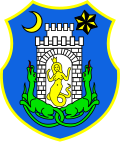Kamnik
| Kamnik | |||
|
|||
| Basic data | |||
|---|---|---|---|
| Country |
|
||
| Historic region | Upper Carniola / Gorenjska | ||
| Statistical region | Osrednjeslovenska (Central Slovenia) | ||
| Coordinates | 46 ° 14 ' N , 14 ° 37' E | ||
| surface | 265.6 km² | ||
| Residents | 28,859 (June 30, 2009) | ||
| Population density | 109 inhabitants per km² | ||
| Telephone code | (+386) 1 | ||
| Post Code | 1240 | ||
| License Plate | LJ | ||
| Structure and administration (status: 2018) | |||
| Mayor : | Matej Slapar ( New Slovenia ) | ||
| Mailing address | Glavni trg 1240 Kamnik |
||
| Website | |||
Kamnik ( German Stein in Krain ) is a municipality with almost 30,000 inhabitants south of the Steiner Alps in the Republic of Slovenia . The city center is about 24 kilometers north of the city center of the capital Ljubljana (Ljubljana).
Municipal area
The municipality is located in the north of central Slovenia and covers a large part of the Steiner Alps with its 265.6 km².
history
Stein in Oberkrain was first mentioned in 1061 as the property of the Counts of Andechs . It has been known as a market since 1188 and as a town since 1267. In the Middle Ages it was one of the most important trading centers in the Duchy of Carniola and was located on the most important road between Laibach and Cilli . With the shift of trade in the 16th century, it lost its importance.
After the establishment of the Ljubljana – Stein railway in 1890, various industrial companies settled here, including Stol (furniture industry), Utok (leather), Titan (door locks), ETA (food) and Svilanit (textile). Some of these businesses, including Utok and Stol, went under after 1990.
Recently, Kamnik is gaining in importance as a place of residence for people who work in Ljubljana, which is reflected in the lively construction activity, but also increasing traffic problems (traffic jams).
Districts of the entire municipality
|
|
|
|
|
Attractions
Kamnik is one of the oldest Slovenian cities and has a medieval town center. Sights include the Mali grad castle ( small festivals ), the Stari grad castle ruins ( Oberstein ) above the town and the library of the Franciscan monastery with around 10,000 books. There is a local history museum in the Zaprice Castle ( Steinbüchel ). The two rivers Nevljica and Kamniška Bistrica ( Feistritz ) converge in the city.
To the south of the city there is a park with an arboretum on the site of the former Volčji Potok ( Wolfsbüchel ) castle , which was blown up after the Second World War .
Town twinning
-
 Gendringen , Netherlands
Gendringen , Netherlands
-
 Andechs , Germany
Andechs , Germany
-
 Ennigerloh , Germany
Ennigerloh , Germany
-
 Trofaiach , Austria
Trofaiach , Austria
-
 Kerns , Switzerland
Kerns , Switzerland
Personalities
- Joannes Baptista Dolar (1620–1673), composer
- Mihael Omerza (1679–1742), composer
- Jurij Japelj (1744–1807), Slovenian writer, Catholic priest and Bible translator
- Rudolf Maister (1874–1934), Yugoslav general
- Ivan Vavpotič (1877–1944), painter and author of the first Yugoslav postage stamps
- Max Gad (* 1954), director and artist
- Stane Zore (* 1958), Archbishop of Ljubljana
Web links
- Kamnik , official website
Individual evidence
- ↑ a b Kamnik: Krajevne skupnosti Accessed on November 15, 2018.
- ↑ Kamnik: Župan.Retrieved January 5, 2019.
- ↑ Miha Kosi (Laibach): City foundation and city development. Problems and examples from the Slovenian area . In: Pro Civitate Austriae. Information on urban history research in Austria , New Series, Issue 14, Austrian Working Group for Urban History Research, Linz 2009, p. 7






